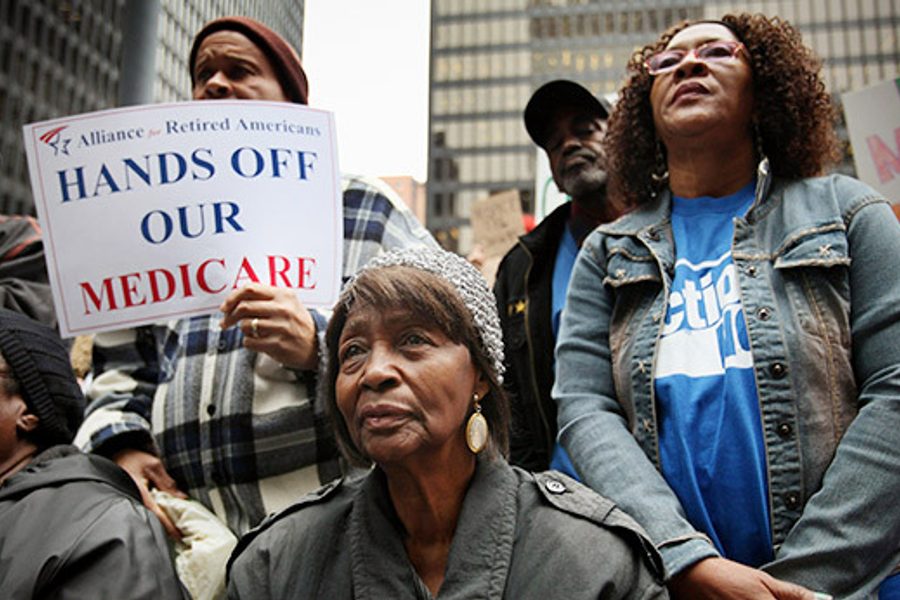
Healthcare reform in the shape of the 2010 Affordable Care Act (aka “Obamacare”) was supposed to relieve working Americans of the burdens of rising healthcare costs as they struggle to survive the jobless recovery.
Instead, working Americans are being confronted with the emergence of a new stage in America’s downward slide on healthcare. “‘Unaffordable under-insurance’ is rapidly becoming the new standard in the United States,” Dr. Don McCanne, senior health policy fellow for Physicians for a National Health Program (PNHP), told In These Times.
One of the most telling symptoms of the “new normal”: Visits to physicians’ office have dropped a stunning 17 percent from the second quarter of 2009 to the second quarter of 2011, according to a recent Kaiser Family Foundation report.
This drop illustrates how the ever-growing burden of healthcare costs — in the form of out-of-pocket deductibles and co-pays — is making Americans reluctant to seek care despite having the supposed protection of health insurance. “We know that a lot of people are foregoing beneficial treatments for conditions like diabetes, or not getting vital preventive services like Pap smears,” McCanne says.
As people’s health conditions deteriorates because of a lack of preventative care, the eventual cost of treatment will be much more costly and the chances of a healthy outcome reduced. With high-deductible insurance plans proliferating among pattern-setting large employers like General Electric, a pattern of unaffordable under-insurance will be well-established by the time that the Affordable Care Act, which will include state-level healthcare exchanges, is fully implemented in 2014.
According to McCanne, the various levels of coverage offered under the ACA will leave working families with the same problem of increasingly skimpy insurance coverage that is too expensive to actually utilize. “The ‘bronze’ plan will have an ‘actuarial value’ of 60 percent, meaning that people will be paying 40 percent of their healthcare costs,” he says.
Government subsidies and maximums on out-of-pocket costs will provide some assistance, but it still appears that the bronze plan will mean that consumers pay about 40 percent, he stated. “The silver plan covers 70 percent [i.e., does not cover 30%] of healthcare costs,” but the premiums will be higher, and most consumers will probably be drawn to bronze plan. But there is little likelihood that healthcare insurance premiums will remain stable under the bronze plan or any other option under the new federal legislation.
Even with usage of insurance declining, fueling huge profits, insurers in California and elsewhere have been jacking up premiums, noted McCanne.
Corporations have been able to force workers to swallow the premium increases, with workers’ share of healthcare costs rising 63 percent between 2003 and 2007. With no effective cost controls contained in the Affordable Care Act — which, after all, was drafted by Wellpoint insurance lobbyist Liz Fowler working alongside the insurers’ pet poodle (see here, here, and here) Sen. Max Baucus (D-Mont.) — the problem of “unaffordable under-insurance” is only going to snowball as we enter the new era of “reform.”
DISAPPOINTING RESULTS FOR ACA THUS FAR
While the ACA has raised hopes that some of the worst abuses of the for-profit insurance industry will be curbed, McCanne and his colleagues at the PNHP caution that insurers are likely to easily circumvent regulations and that the ACA will be able to keep healthcare affordable.
As PNHP leaders pointed out after passage of ACA in early 2010, “The much-vaunted insurance regulations — e.g., ending denials on the basis of pre-existing conditions — are riddled with loopholes, thanks to the central role that insurers played in crafting the legislation.” For example, the ACA’s program for people with pre-existing conditions has enrolled a mere fraction of those expected to sign up, as insurance remains prohibitively expensive.
Overall, McCanne said, we appear to be headed toward a new health crisis where most people find themselves among the ranks of the “unaffordable under-insured” and healthcare is increasingly delivered in a rigidly-tiered system based on ability to pay.
Poor people depending on Medicaid will be especially hard-hit as the new breed of conservative governors exemplified by Wisconsin’s Scott Walker slash Medicare rolls. The limitations of ACA-style reform — which the Obama administration chose to build around the mammoth and unproductive bureaucracy of the for-profit insurance industry, are becoming increasingly apparent.
Some of the most highly-touted features of the ACA features contain built-in problems, PNHP leaders noted last year. For example, “Older people can be charged up to three times more than their younger counterparts, and large companies with a predominantly female workforce can be charged higher gender-based rates at least until 2017.”
Moreover, “About 23 million people will remain uninsured nine years” into ACA’s existence, according to PNHP.
At the same time, the affordability and coverage of those with insurance will continue to deteriorate — until the bottom 99% start to rebel against a health system shaped to maximize the profits of insurers who seek to minimize care. The Occupy movement offers a hopeful sign that Americans are recognizing that the healthcare system, like other U.S. institutions, functions to benefit the top 1% at the expense of the vast majority, McCanne said.
For McCanne and fellow health professionals in PNHP, the downward spiral in healthcare will finally end only with the United States installing a Canadian-style “Medicare for all” single-payer system that puts a halt to the machinations of for-profit insurers.








